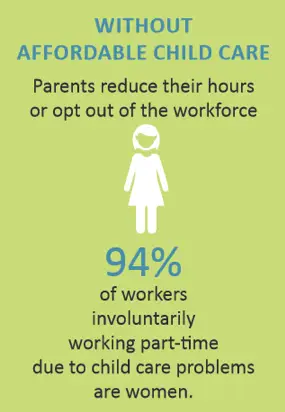Download News Release (.doc)
Alabama’s Economy Depends on Working Parents and Child Care
Alabamians are going to work. Nearly 100,000 more of the state’s residents were employed in August 2019 compared to two years earlier.[1] That’s based on the latest data from the U.S. Bureau of Labor Statistics and works out to roughly an extra two out of every 100 Alabamans over the age of 15 collecting a paycheck. The recent good news continues a long-running trend in Alabama, where the share of adults with a job has risen to its highest point in nearly eleven years and resulted in the state’s lowest unemployment rate on record.
To further foster this trend, it is important to understand the critical role child care is playing in boosting Alabama’s economy. Child care isn’t only a means to providing parents with the option of work. By enabling more Alabama parents to find or keep a job and balance work with their family responsibilities, child care also unlocks an important source of talent for Alabama employers. Plus, it is an important industry in its own right. Over 16,000 Alabamians are paid for work related to child care, and the state’s child care sector as a whole is estimated to generate direct revenues and support for additional education and work that, taken together, are worth more than $800 million annually.[2]

Alabamas Economy Depends on Working Parents and Child Care Tuscaloosa forum November 20 2019 (approved) This fall, the Chamber of Commerce of West Alabama, West Alabama Works, and the Alabama Partnership for Children held a forum where employee child care challenges were discussed. Employers identified the lack of affordable, accessible child care for employees – including the availability of child care during non-traditional hours as well as related issues such as the low pay earned by the child care workforce, which impacts the supply of and growth in the industry to provide access to child care. These issues are connected because the supply of child care is related to the availability of a child care workforce to provide child care services. In a good economy where workers can earn higher wages in the fast food industry or retail sales, it’s challenging to retain child care programs in the community – let alone grow them to meet employee demand.
One sign of how important child care is for employers and employees alike is that, by one estimate, businesses nationwide lose more than $4.4 billion a year due to employee absences resulting from breakdowns in child care arrangements.[3] Parents who struggle to find reliable child care may be limited in the hours they can work or the jobs they can perform. And research from the U.S. Department of Health and Human Services found that lowering the cost of child care paid by parents significantly increases the likelihood that a mother will work.[4]
Mothers, who typically bear the brunt of parental child care responsibilities, are a significant part of Alabama’s workforce. Across the state, more than 200,000 families with children under age 12 include a mother who works or is looking for work.[5] Even among mothers with small children, most participate in the workforce. Last year, about 67.8 percent of women with children under age 6 were in the state’s labor force.[6] But that contribution to Alabama’s economy depends on the availability of and access to child care, often purchased from one of Alabama’s more than 7,000 market-based child care providers.[7] The result is that about 56.7 percent of Alabama children from birth to age five spend more than ten hours per week in the care of someone other than their parents.[8] Knowing from research about the impact of adult interactions on a child’s development in those key years from birth to age 5, early learning providers play a crucial role on the impact of those educational settings which help build the foundation for future success in life.
Those findings, drawn from the Committee for Economic Development of The Conference Board’s report, “Child Care in State Economies,” help reinforce the key role child care plays in facilitating the work of parents and strengthening Alabama’s workforce. And with so many Alabama children spending significant time in non-parental care, it is clear that access to affordable, quality child care will matter not just for today’s workers and employers, but for the healthy development and school readiness of the state’s next generation of potential workers and citizens as well.
The consensus at the Tuscaloosa forum was that both partnerships with the business community and additional state funding is needed to address employee access to child care (e.g., affordability), the child care supply shortage (e.g., availability of child care), and workforce compensation strategies (e.g., state wage supplements or tax credits to retain and grow the child care workforce). With an anticipated 500,000 additional workers needed by 2025 throughout Alabama, we can’t afford to ignore current child care challenges. These are challenges with solutions. The time is now to join all stakeholders and develop strategies to ensure that addressing employee child care challenges is a top priority. The future prosperity of our state depends on it.
Gail Piggott, Executive Director – Alabama Partnership for Children
Jim Page, President & Chief Executive Officer – The Chamber of Commerce of West Alabama
[1] Authors’ calculations based on “States and selected areas: Employment status of the civilian noninstitutional population, January 1976 to date, seasonally adjusted,” Bureau of Labor Statistics, accessed on October 9, 2019. Alabama’s employed civilian labor force increased from 2.088 million in August 2017 to 2.185 million in August 2019, and the share of the civilian noninstitutional population employed increased from 54.4 percent to 56.6 percent.
[2] “Child Care in State Economies: 2019 Update,” Committee for Economic Development of the Conference Board (CED), January 2019.
[3] “Parents and the High Cost of Child Care: 2017,” Child Care Aware of America, 2017.
[4] Kimberly Burgess, Nina Chien, Maria Enchautegui, “The Effects of Child Care Subsidies on Maternal Labor Force Participation in the United States,” US Department of Health and Human Services, December 2016.
[5] Authors’ calculations based on Sarah Flood, Miriam King, Renae Rodgers, Steven Ruggles, and J. Robert Warren,
“Integrated Public Use Microdata Series, Current Population Survey: Version 6.0,” Minneapolis, MN: IPUMS, 2018.
[6] [6] U.S. Census Bureau, Table S 2301, 2018 American Community Survey, 1 Year Estimates. https://data.census.gov/cedsci/table?q=s2301&lastDisplayedRow=25&table=S2301&tid=ACSST1Y2017.S2301&hidePreview=true&g=0400000US01
[7] “Child Care in State Economies: 2019 Update,” Committee for Economic Development of the Conference Board (CED), January 2019.
[8] Ibid.
